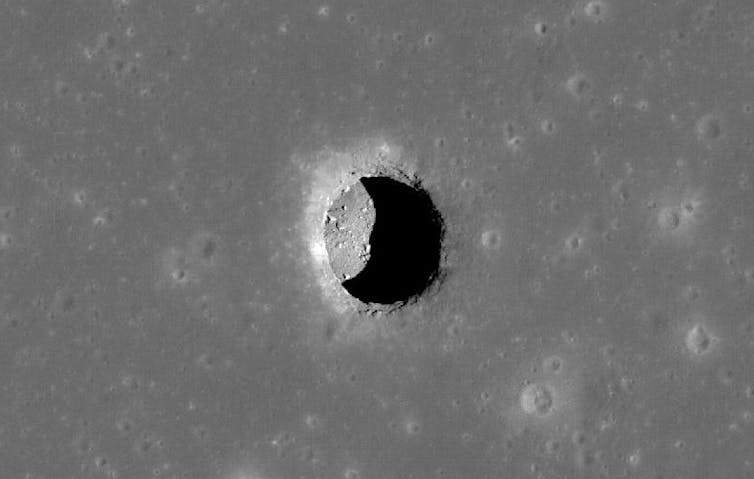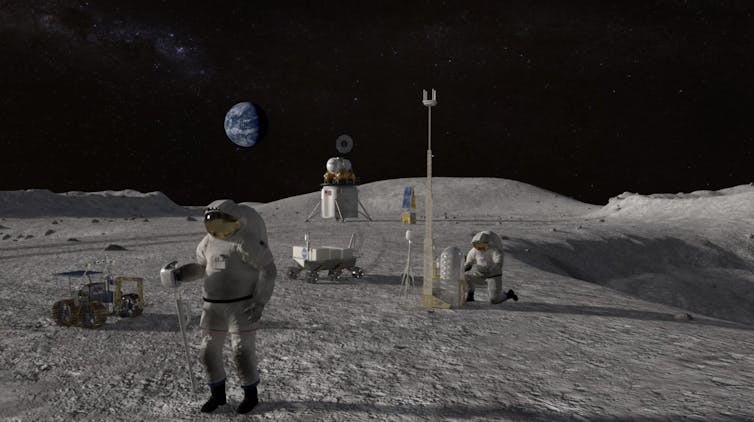

Dr Christopher Pattison, Research Software Engineer, writes for The Conversation.

,
Almost 55 years after the launch of Apollo 11 – the first mission to land humans on the Moon – scientists have found evidence of a large cave system near the landing site of those astronauts.
Using radar images taken by in 2010, researchers have been able to determine that huge pits, found in images of the Moon, may in fact be “skylights” to large caves and tunnels that sit beneath the lunar surface.
These could be incredibly valuable to future astronauts hoping to settle on the Moon, acting as a convenient shelter for a lunar base.
The cave is accessible through a pit in the well-studied (Sea of Tranquility). This is a large basin made mostly of basalt. Neil Armstrong and Buzz Aldrin touched down in this region on July 20 1969.
While Mare Tranquillitatis isn’t likely to be the first place humans try to settle on the Moon, the existence of one cave makes the existence of others very likely, so scientists now expect there to be others in locations more suitable for human settlement.
Mare Tranquillitatis isn’t scientists’ first choice for a human base because it doesn’t have one of the other important ingredients needed for survival. There is no ice at the lunar equator and therefore no for astronauts to drink, make oxygen from and to split for rocket fuel. This makes the equator great for landing on and visiting, but a poor choice for setting up camp.
Ice is likely to exist at the lunar poles, though, thanks to shade protecting it from the Sun’s harsh rays. So the poles are our first choice for starting to settle on the Moon as it reduces the amount of water we would need to take with us.

The opening being studied here is simply known as the Mare Tranquillitatis pit, and it’s one of about 200 known openings on the lunar surface. It was first imaged back in 2010 and suspected to be a pit that led into a cave or tunnel system, but we had no way of confirming this until now.
In a paper , Leonardo Carrer, from the University of Trento, Italy, and colleagues report evidence that this pit does indeed lead to a cave below, and possibly to a larger system of tunnels and conduits. The Mare Tranquillitatis pit is about 100 metres (330 feet) wide, with steep walls that stretch down between 130 and 170 metres, making it the deepest known lunar pit.
By re-analysing the radar data and by using computer simulations to reconstruct the pits, scientists were able to determine that a portion of the radar reflected back to the satellite was coming from a subsurface cave conduit that is at least tens of metres long. This suggests that the Mare Tranquillitatis pit leads to an accessible cave below the Moon’s surface.
Exciting prospect
This discovery is incredibly exciting, not least because it’s a promising potential location for future lunar shelters and bases. As well as providing natural shelter from harmful cosmic rays, a cave system also provides a stable temperature.
The lunar surface temperature fluctuates hugely over a period of weeks because of the lack of atmosphere to retain heat. During the lunar day, temperatures can spike at 121°C (250°F) in sunlight, then plummet to -133°C (-208°F) after nightfall. The shade of an underground cave system is expected to regulate the temperature to be much more consistent, making building a shelter within them much easier.
Similarly, small asteroids often crash into the Moon due to its lack of atmospheric shielding. Being in a shelter that is sturdy enough to survive an impact is important. A cave provides the perfect solution to this.
While having a cave to shelter in might reduce the amount of materials we need to take to the Moon to start to settle there and have a long-term human presence, there are still some obstacles to overcome.
For example, the walls of the pit are a sheer drop and are over 100 metres tall, meaning future explorers will need to find a safe way to descend into the caves and ascend when they are exploring the surface.
This could take the form of ladders, or more complicated systems . Thankfully, though, the lower lunar gravity means this problem is less severe than it would be on Earth. The structural integrity of the caves will also need to be assessed before we move in.
The study also revealed that the underground system could be between 30 to 80 metres (98 to 262 feet) long and around 45 metres (148 feet) wide. This would make it large enough for several “lunar houses”. The floor also appears to be flat enough to build on without any major work or preparation.
The most likely cause of lunar caves is that they are old . These are tunnels that formed when the Moon was still volcanically active millions of years ago. Flowing lava can develop a continuous and hard crust, forming a roof above the still-flowing lava stream. A hollow then exists once the lava stops flowing.
Even better than the cave at Mare Tranquillitatis, would be the discovery of other such structures near either of the lunar poles. Astronauts would then have the best of everything – a shelter against the harsh conditions of the Moon and access to that exists in shadowed craters at the lunar poles. This would be an excellent chance to reduce the cost and difficulty of settling on the Moon for a prolonged period.
The fact that we can spot them from space also allows us to plan missions to use these natural shelters. It could mean that future astronauts live in volcanically formed caves on the Moon.
, Researcher at the Institute of Cosmology and Gravitation,
This article is republished from under a Creative Commons license. Read the .
More articles from The Conversation...
Is dark matter’s main rival theory dead? There’s bad news from the Cassini spacecraft and other recent tests
Harry Desmond
10 May 2024
3 minutes

The ancient Egyptian goddess of the sky and how I used modern astronomy to explore her link with the Milky Way
Or Graur
3 May 2024
4 minutes

If life exists on Jupiter’s moon Europa, scientists might soon be able to detect it
Dr Lucinda King
5 April 2024
5 minutes

